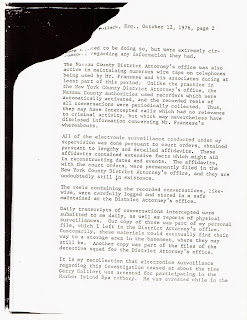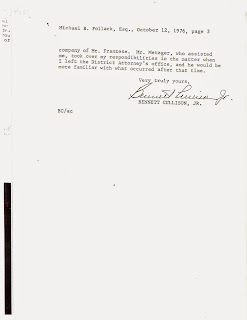Missing Letter Describes Fate of Franzese Surveillance Records From Storied Bank Robbery Trial
COSA NOSTRA NEWS EXCLUSIVEA letter from 1976 written by former District Attorney Bennett Cullison Jr. to Michael B. Pollack, attorney for John “Sonny” Franzese following his 50-year conviction in 1970 for “masterminding” a series of bank robberies, raises questions regarding the fate of surveillance records of the legendary gangster taken by several law enforcement agencies.
Pollack, who has since been disbarred, was not available for comment. As the trial took place about 40 years ago, it has been difficult finding law-enforcement sources to comment. Some key figures involved in the trial have died and long and careful searching failed to turn up any sources' contact info. A voicemail has been left with the press departments of some agencies. This report will be updated if new information arises.
The letter by admits that surveillance records were, as of then, either “destroyed” or in storage in the D.A.’s office, which Cullison had departed to pursue private practice before writing the letter to Pollack.
Franzese was convicted and sentenced to 50 years for managing a series of bank robberies across the nation which were committed in the mid-1960s by John Cordero, Jimmy Smith, Richie Parks and Charles Zaher.
Over the years, high-profile journalists have come forward and expressed doubt regarding the strength of the case against Franzese, whether he was really guilty or a convenient scapegoat, and whether the FBI had overstepped its bounds.
According to an article by J. R. de Szigethy posted on Rick Porrello’s AmericanMafia.com site, former New York Post columnist Jack Newfield had penned a detailed report on various crimes committed by FBI agents to set up Franzese for the bank robbery. "One disturbing aspect of this case was revealed years later when Michael Gillen, the prosecutor made a startling confession to Sidney Zion, the New York Times reporter who covered the trial; 'Gillen admitted to me that he intentionally went drinking with me one night in the hotel bar to keep me distracted while two FBI agents broke into my car and photographed my notes and files.'"
Aside from the media, all four witnesses who had fingered Franzese recanted their testimony at one time or another.
A sworn affidavit by the wife of one of the robbers stated that Franzese and other defendants convicted in the 1967 trial were not involved in the robberies. It also stated that the supposed getaway driver, Anne Messineo, was not the driver at all; she too was framed.
Surveillance evidence, as the letter indicates, was either destroyed or put in storage. It was never turned over to the Franzese defense team, according to sources close to the case. Judge Mishler, a federal judge for the United States District Court for the Eastern District of New York, who presided over Franzese’s trial, refused to rule in Franzese’s favor after several appeals – one of which included the results of a lie-detector test Franzese had taken and passed -- at Mishler’s own suggestion. No appeal, said Mishler.
Tina Franzese, wife of Sonny Franzese, is still working on appealing the verdict, which she says, “destroyed my family.”
“When Gillen was asked if there were any surveillance records related to Sonny, he said, ‘Nothing that I have received.’
“We started trying to find out what happened to the surveillance records.
“They did such a job on Sonny. He got 50 years, every one else was out in five to six years.
“This letter tells us they all lied when they said there was no surveillance. Michael Pollack knew about this letter, and we never got it.” Tina Franzese believes Pollack buried the letter for any one of a variety of reasons. “We think he used it for his own reasons,” she said.
The reason Franzese’s appeal team wants the surveillance evidence is that they believe it will vindicate the 93-year-old mobster. If it implicated him, Tina said, “they would have showed it in court and gave it to us.
Surveillance evidence, as the letter indicates, was either destroyed or put in storage. It was never turned over to the Franzese defense team, according to sources close to the case. Judge Mishler, a federal judge for the United States District Court for the Eastern District of New York, who presided over Franzese’s trial, refused to rule in Franzese’s favor after several appeals – one of which included the results of a lie-detector test Franzese had taken and passed -- at Mishler’s own suggestion. No appeal, said Mishler.
Tina Franzese, wife of Sonny Franzese, is still working on appealing the verdict, which she says, “destroyed my family.”
“When Gillen was asked if there were any surveillance records related to Sonny, he said, ‘Nothing that I have received.’
“We started trying to find out what happened to the surveillance records.
“They did such a job on Sonny. He got 50 years, every one else was out in five to six years.
“This letter tells us they all lied when they said there was no surveillance. Michael Pollack knew about this letter, and we never got it.” Tina Franzese believes Pollack buried the letter for any one of a variety of reasons. “We think he used it for his own reasons,” she said.
The reason Franzese’s appeal team wants the surveillance evidence is that they believe it will vindicate the 93-year-old mobster. If it implicated him, Tina said, “they would have showed it in court and gave it to us.
“If it showed the robbers with Sonny, it would have helped prove their case. But we didn’t get any of it. They denied information to us. Lawyers were denied the material.”
Director/producer Chris Selletti, a friend of the Franzese family, has been assisting Tina in putting together another appeal and is also producing a documentary called “Framed,” which will detail the Sonny Franzese story through reenactments and interviews with people close to the case.
“This letter proves there were surveillance records,” Selletti said.
“Some were destroyed, some were put in storage. Michael Pollack, for some reason, didn’t use them in the appeal.” In fact no one had ever seen the letter from the former D.A. confirming that surveillance records did or still exist until Selletti got hold of several crates of trial transcripts and other materials. He found the letter among the papers.
Tina Franzese said she has affidavits from 500 people who had seen the Franzeses under constant surveillance back in those days, when the robberies were taking place.
A 1975 appeal on Franzese’s behalf was bolstered by the affidavit dated Oct.19, 1974, by Eleanor Cordero, wife of John Cordero, one of the four confessed participants in the robberies. In summation, it reads that the testimony of these four was the principal, indeed almost the sole, basis of the government's case. The thrust of Mrs. Cordero's affidavit was that the 1965 robberies had been committed by some or all of the confessed participants, as testified at the trial, but with Eleanor playing an important role and Anne Messineo playing none (Messineo was named by the robbers as their driver, a role which in fact Eleanor had played). Further, the affidavit stated that Franzese and other defendants convicted in the 1967 trial were not involved in the robberies.
The affidavit went on to say that after the arrest on Oct. 1, 1965, she met with her husband on a number of occasions at the West Street Detention Center and at the office of the Assistant United States Attorney, Mr. Gillen; that "during this time" John told her that he, Parks, Smith and Zaher "concocted a story to involve the Polisis [small-time gangsters of that era] as the masterminds of the robberies" and had substituted Anne Messineo for her "to give further credence to their story, since she (Anne) was associated with the Aqueduct" Motor Inn which Anthony Polisi owned.
Later, when the four learned that the sole benefit they would receive for involving the Polisis was that they would get only 25 years rather than 125, they devised a scheme to implicate Franzese, a gangster of major importance in both the mob and law enforcement. Eleanor Cordero had never met Franzese; John Cordero had never mentioned his name in connection with the robberies in question; there were no floor plans and no central organization devised escape routes or procured stolen cars for the participants' benefit.
The smoking gun in this case, according to Tina Franzese and Chris Selletti, is the letter written and delivered to former Franzese attorney Michael B. Pollack decades ago in answer to a request initially sent to the D.A.’s office by Pollack regarding the status and location of the surveillance evidence gathered for use against Franzese.
During the course of the trial, the D.A.’s office never produced surveillance evidence, relying solely on the words of the four bank robbers, according to Tina Franzese, which agrees with Eleanor Cordero’s affidavit.
Franzese has spent about 25 of the past 40 years behind bars for the bank robbery conviction back in 1967. Sentenced to 50 years, Franzese served part of his time and was eventually released on parole -- but he was sent back to prison five times for violations.
Last year Franzese was hit with eight years in prison for extorting Hustler and Penthouse magazines for $150,000. With time off for good behavior, the 93-year-old gangster should be out by February 19, 2017, which is his 100th birthday.
Tina also used last year’s trial to distribute a press release about “Framed,” the documentary that Selletti is making about the controversial Franzese bank robbery case.
The film contains interviews with Tina Franzese, among others, and also features re-creations based on affidavits by four trial witnesses who later recanted their testimony and fingered FBI agents as architects of the plot to frame Franzese. A small preview edited from what so far has been shot was shown last November to select members of the media.
http://cosa-nostra-news.blogspot.com/2011/03/missing-letter-describes-fate-of.html#more





0 comments:
Post a Comment